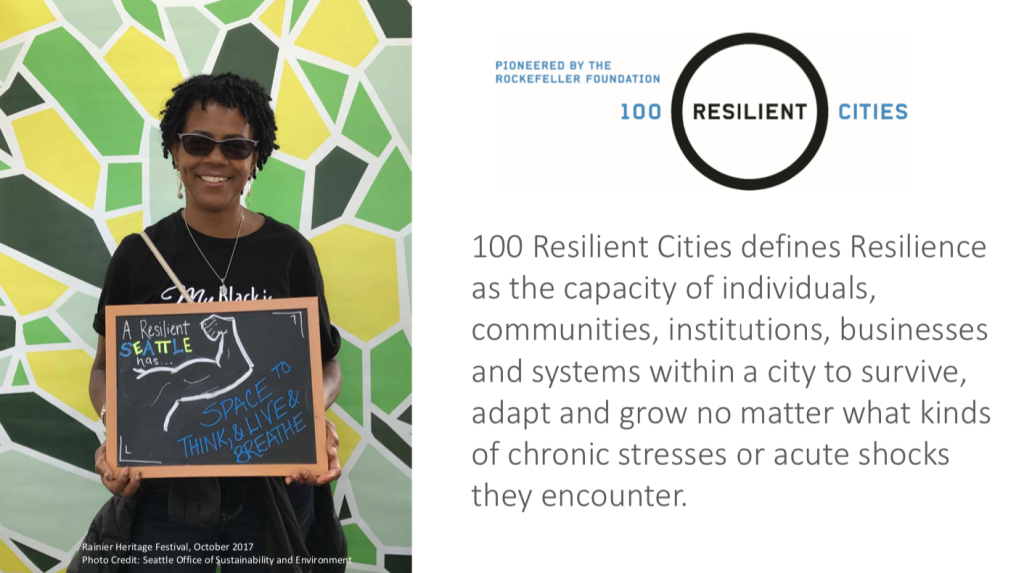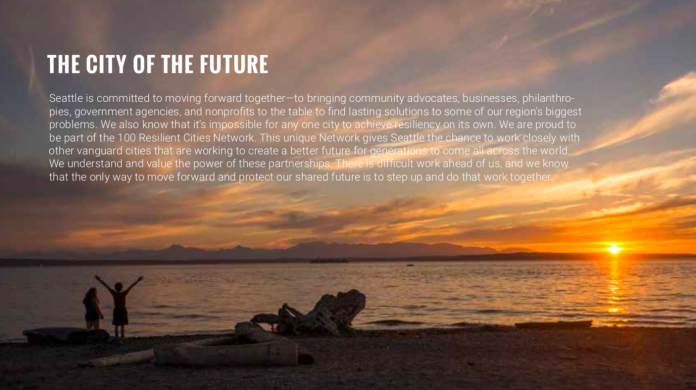I first learned about the release of the Seattle – Future City: Resilience Roadmap from an article published by Smart Cities Dive. Previous to that I had heard the term “urban resilience” thrown around quite a bit, but I did not know that Seattle had been chosen back in 2016 to join 100 Resilient Cities (100RC), a global network of cities formulating urban resilience strategies funded by the Rockefeller Foundation–which has a $4 billion endowment seeded from the fortune John D. Rockefeller, Sr. amassed operating an oil monopoly during the Gilded Age.
According to 100RC, urban resilience is defined as “the capacity of individuals, communities, institutions, businesses, and systems within a city to survive, adapt, and grow no matter what kinds of chronic stresses and acute shocks they experience.”

From social and economic inequality, to the environmental threats posed by the climate crisis, cities sit on the frontlines of a wide range of 21st century challenges. The Rockefeller Foundation created 100RC after observing the devastating consequences of Hurricane Katrina and Superstorm Sandy. But what started out as a environmental disaster and climate crisis inspired mission soon was amplified to include additional significant stressors on the urban environment like racial inequality, endemic violence, and inefficient public transportation.
Cities selected for the 100RC effort were given funding to hire Chief Resilience Officers, create resilience plans, and share and receive technical assistance from an international network of partner cities.
Local customization of resilience strategies became a cornerstone of 100RC’s work. Cities were encouraged to adopt programs and policies that addressed their own particular challenges. But while local customization became identified as a signature element of 100RC’s work, it faced scrutiny by the Rockefeller Foundation’s board who wanted to see funding delegated to programs that would achieve results that were easier to measure and would have more immediate impact on vulnerable people’s lives.
So in the spring of 2019, funding for 100RC ended, and the previous 30 to 40 million dollars that was spent annually on 100RC’s work was shifted by the Rockefeller Foundation to supporting maternal and children’s health and renewable energy solutions in the developing world.
All of this happened right when the City of Seattle was preparing its own Resilience Roadmap, and unfortunately the upheaval caused by the closure of 100RC left its mark on the publication Seattle produced. According to Smart Cities Dive, while Seattle participated in two years of research and planning through 100RC, the City only had about three months to finalize its report.

As a result, in comparison to the work achieved by other cities, Seattle’s Resilience Roadmap feels rushed and strangely backward looking. Reading through it, I was struck by how the material resembles a laundry list of achievements accomplished by current Mayor Jenny Durkan’s administration. Almost every section of Seattle Resilience Roadmap is grounded in references to ordinances and levies that were passed in the last few years.
All of this casts the information in the report in a retrospective, rather than forward focused light. But that’s probably due to the fact that it was completed after Rockefeller Foundation’s announcement. Taking that context into consideration, it’s easier to understand why the report presents more accomplishments than visions for the future. “Look at all the good work we achieved under the banner of 100RC,” the report seems to cry out.
In a broadcast that explained to the worldwide 100RC network why the effort was folding, Rockefeller Foundation President Raj Shah, who had previously served as the chief administrator of the federal U.S. Agency for International Development (USAID), explained that it was difficult to measure the results of all the different efforts being undertaken by cities because of long timeframe and complex nature of the goals being addressed. By presenting a long list of measurable achievements, Seattle’s Resilience Roadmap presents a direct counterargument to this statement; however, the counterargument is undercut a bit by how many of the strategies are narrowly focused and short-term in nature.

The shortcomings of Seattle’s Resilience Roadmap are especially disappointing because Seattle was a leader in bringing racial equity to the forefront to discussions of urban resilience. Because of Seattle’s leadership in this area, it’s hard not to feel a flicker of jealousy when reading the report completed by Los Angeles, which was one of the first North American cities chosen to join the effort. Perhaps Seattle could have produced a similarly robust Resilience Roadmap if given more time.
What does Seattle’s Resilience Roadmap include?
Overarching goals are probably the most interesting aspect of the Seattle Resilience Roadmap, both for what is included and left out. After reviewing its existing plans and initiatives, the City solidified its roadmap into a list of four chapters, 15 goals, and 69 actions.

The breakdown of chapters and goals includes:
- Chapter One: Building Opportunity – Goals include: closing the opportunity gap, creating pathways to jobs, and preparing all Seattle workers for the jobs of the future.
- Chapter Two: Making Seattle More Affordable For All – Goals include: building more affordable housing, preventing displacement, creating a connected and affordable transportation network, and helping residents meet basic needs.
- Chapter Three: Creating a City Where Everyone is Welcome – correcting historic injustices in the criminal justice system, protecting our most vulnerable communities, standing up for all of Seattle’s workers
- Chapter Four: Fostering Generational Investments – serving as a model employer by driving equitable outcomes, re-imaging and enhancing civic treasures, meeting the needs of our growing city, combatting climate change, harnessing the power of partnerships
Right away some of what Seattle’s Resilience Roadmap lacks in content is readily apparent. For an initiative that started out with the goal of combatting the climate crisis and preparing cities for natural disasters, Seattle’s report contains only one slim section devoted to its current strategies for combatting climate change, such as exploring if congestion pricing can be implemented equitably and reducing the amount of homes dependent on oil heat.
For a city as threatened by earthquakes as Seattle is, the even shorter shrift given to natural disaster preparedness is a major weakness of the report. In comparison to Los Angeles’s Resilience Roadmap, which takes on social inequality and environmental disaster, Seattle’s report feels too limited. By focusing on areas where accomplishments have already occurred, major issues, such as fact that many of Seattle’s public schools needs seismic retrofits are left unaddressed. It’s hard to believe that any roadmap for Seattle’s future would not provide a plan for ensuring the safety of thousands of public school children, or all the people who live and work in buildings that could collapse in an earthquake.
In an article on CityLab that addresses the “demise” of 100RC, the prospect of the an urban resilience effort reemerging with funding by the Rockefeller Foundation that addresses work that is achieved on a “project by project” basis is raised. While such work would certainly please funders because of its increased accountability, it will also probably lack some of what made the initial efforts for 100RC so remarkable. What 100RC seemed to understand is that cities are complex ecosystems. Establishing urban resilience doesn’t result from disconnected programs and policies; instead it arises when the interconnected nature of urban and environmental challenges is acknowledged.
Natalie Bicknell Argerious (she/her) is a reporter and podcast host at The Urbanist. She previously served as managing editor. A passionate urban explorer since childhood, she loves learning how to make cities more inclusive, vibrant, and environmentally resilient. You can often find her wandering around Seattle's Central District and Capitol Hill with her dogs and cat. Email her at natalie [at] theurbanist [dot] org.


